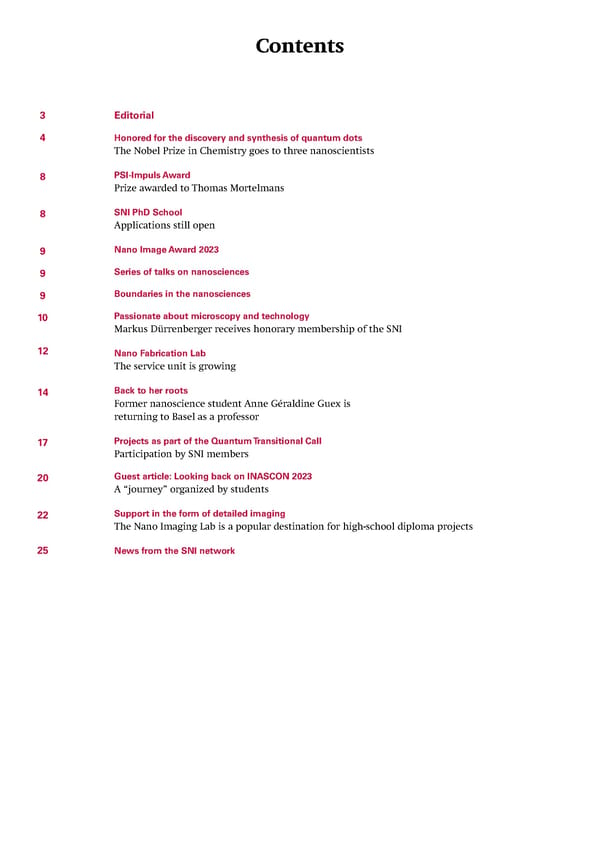SNI INSight December 2023
Showcasing research and activities at the Swiss Nanoscience Institute
SNI INS ight Showcasing research and activities at the Swiss Nanoscience Institute December 2023 Nobel Prize for Honorary SNI member Back as a professor Valuable experience quantum dots Interview with Markus Dürrenberger on Géraldine Guex becomes a The organizing team Jonathan de Roo his career history new member of the SNI report on INASCON 2023
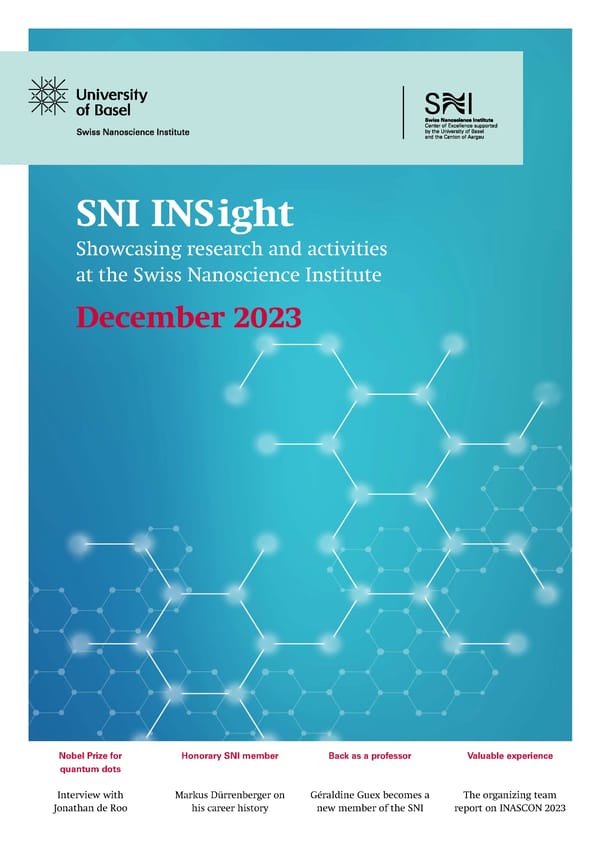
Contents 3 Editorial 4 Honored for the discovery and synthesis of quantum dots The Nobel Prize in Chemistry goes to three nanoscientists 8 PSI-Impuls Award Prize awarded to Thomas Mortelmans 8 SNI PhD School Applications still open 9 Nano Image Award 2023 9 Series of talks on nanosciences 9 Boundaries in the nanosciences 10 Passionate about microscopy and technology Markus Dürrenberger receives honorary membership of the SNI 12 Nano Fabrication Lab The service unit is growing 14 Back to her roots Former nanoscience student Anne Géraldine Guex is returning to Basel as a professor 17 Projects as part of the Quantum Transitional Call Participation by SNI members 20 Guest article: Looking back on INASCON 2023 A “journey” organized by students 22 Support in the form of detailed imaging The Nano Imaging Lab is a popular destination for high-school diploma projects 25 News from the SNI network
Editorial the retired head of the Nano Imaging Lab. Also new to the SNI is Géraldine Guex, who joins as principal investigator of a PhD School project. Guex was actually part of the SNI many years ago as a nanoscience student. Now, after working in various other roles, she has returned to the University of Basel as an assistant professor. We also bring you good news in relation to other young scientists. Thomas Mortelmans, a former SNI doctoral student, recently received the PSI-Impuls Award 2023. This prize is awarded every two years for the best appli- cation-oriented doctoral dissertation at the PSI. Congrat- ulations! Furthermore, praise and thanks goes to the students and doctoral students of the nanosciences who organized the INASCON student conference this summer. The guest SNI INSight provides an insight into this article in this special conference, which is organized by and for nano- science students. Dear colleagues and nanoenthusiasts, This edition also includes much more information on the Another year is drawing to a close — and it has been a tur- fascinating topics that we deal with on a daily basis. bulent one, with distressing news from various parts of Without further ado, I’d like to wish you a relaxed and en- the world along with many positive moments, encounters joyable holiday season and a great start to what will hope- and innovations. In these uncertain times, it isn’t always fully be a healthy, peaceful and prosperous New Year. It’s clear how we will overcome the challenges of today and a real pleasure to work with you all. I’d especially like to tomorrow. One thing is certain, however: We will only be thank you for your valuable collaboration and so much able to overcome them by working together. positive and productive teamwork. I’m already looking “Working together” is also one of the guiding principles forward to our many meetings and discussions in 2024! that we are currently elaborating at the SNI, where collab- Kind regards, oration has always taken place across di昀昀erent disciplines and institutions. It’s what makes us so special, but it can also be challenging at times. With the strategy paper still un昀椀nished, we’re bound to engage in further discussions on the orientation of our network. For me personally, the process of developing a strategy for the next 10 years is undoubtedly a signi昀椀cant way to deepen my identi昀椀ca- tion with the SNI and appreciate the value of the many Prof. Martino Poggio, SNI director opportunities that our network has to o昀昀er. In this edition of SNI INSight, you too can immerse your- self in the world of the SNI and the nanosciences. We begin with an article on the three scientists who received the Nobel Prize in Chemistry this year. By working with special nanocrystals, the researchers opened the door to numerous applications, some of which are also being ex- plored within the SNI network. As well as reports on current research projects, SNI INSight also includes information on members of the SNI. For example, we’ve interviewed our new honorary member Markus Dürrenberger, who has made valuable contributions to the SNI as an expert in microscopy and as SNI INSight December 2023 3
Honored for the discovery and synthesis of quantum dots The Nobel Prize in Chemistry goes to three nanoscientists This year’s Nobel Prize in Chemistry has been awarded to the three nanoscientists Professor Moungi G. Bawendi (MIT, Cambridge, MA, USA), Professor Louis E. Brus (Columbia University, New York, USA) and Dr. Alexei I. Ekimov (Nanocrystals - Technology Inc., New York, USA). Their research has paved the way for the applica tion of versatile nanocrystals known as quantum dots – that, like other nanostruc- tures, are subject to the rules of quantum mechanics. We interviewed Professor Jonathan de Roo from the Department of Chemistry at the University of Basel to 昀椀nd out more about these special nanocrystals and about the nanocrystal applications he is exploring in his research. SNI INSight: What are quantum dots and what’s so varying the size of the particles, it’s therefore possible to special about them? de昀椀ne the emission wavelength of quantum dots and, ac- cordingly, the energy or frequency of the light they emit. Jonathan de Roo: Quantum dots are colloidal — that is, 昀椀nely dispersed — semiconductor crystals that measure SNI INSight: How can this phenomenon be only a few nanometers in diameter. These tiny particles explained in simple terms? contain just a few hundred or thousand atoms, and their properties vary depending on their size. One such proper- Jonathan de Roo: If we expose a quantum dot to light, ty is their color when excited by exposure to light — for the electrons in the semiconductor material absorb ener- example, small quantum dots glow blue when excited gy and rise to a higher energy level. When they fall back with UV light, whereas medium-sized quantum dots emit to their original energy level, they give o昀昀 electromagnet- green light, and larger quantum dots emit red light. By ic waves in the form of light. The color of this light de- At the SNI’s Annual Event, Jonathan de Roo described his work with colloidal nanocrystals. SNI INSight December 2023 4
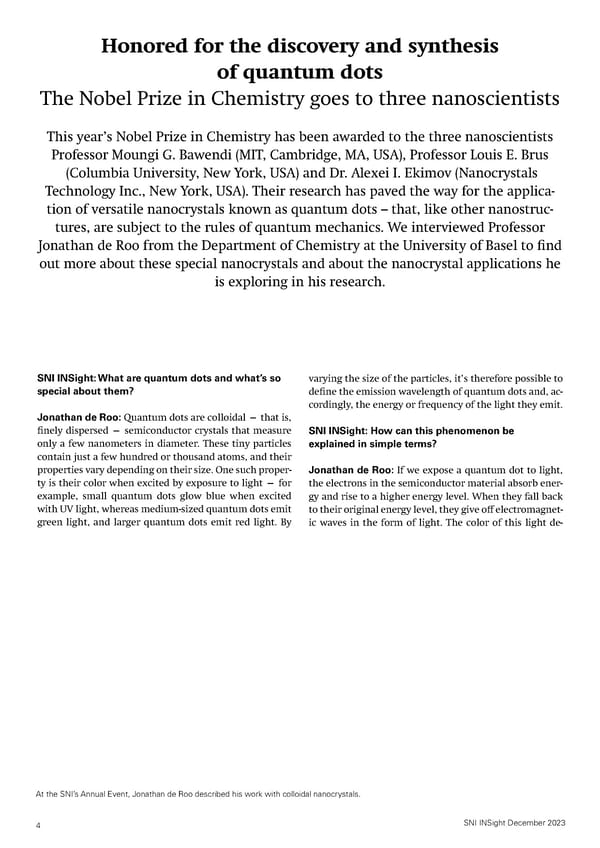
Further information: Webpage Nobel Prize https://www.nobelprize.org Research group Jonathan de Roo https://deroo.chemie.unibas. ch/en/ Quantum dots are colloidal — that is, 昀椀nely dispersed — semiconductor crystals that measure only a few nanometers in diameter. Depending on their size, they have different properties — for example, their color when excited with light. (Image: Stockphoto) pends on the energy di昀昀erence between the In 1993, Moungi Bawendi successfully applied excited state and the ground state. Although the “hot injection method” to the chemical quantum dots can absorb light with a wide production of quantum dots with a homo- range of energies, the color of emitted light geneous size for the 昀椀rst time — thereby then depends on the size of the crystals. achieving the fundamental prerequisite for practical applications of quantum dots. We can think of this as being like an organ, in the sense that a short organ pipe produces To this end, Bawendi’s team injected organo- a high-pitched sound with a high frequency, metallic cadmium compounds together with whereas a long pipe produces a deep sound organic selenium compounds into a hot with a low frequency. If the crystals of the solvent that also contained surfactants. The quantum dots are small, the emitted light high temperatures caused the organic parts is high-frequency and high-energy — and of the organometallic molecules to break therefore blue. If the crystals are large, on down, and the metal ions bonded with the the other hand, the emitted light has a lower selenium to form cadmium selenide nano- frequency and a longer wavelength — and is crystals. Meanwhile, the surfactants in the red in color. solution ensured that the crystals were 昀椀nely dispersed. Although the crystals would con- SNI INSight: What exactly did the three tinue to grow while the temperatures were Nobel laureates investigate? still high (between 240 and 360°C) and su昀케- cient source material was available, Bawendi Jonathan de Roo: In the early 1980s, Alexei repeatedly took samples and stopped the Ekimov studied glasses that contained 昀椀ne- crystallization process within them. By do- ly dispersed copper chloride nanocrystals. ing so, he obtained a series of liquids each Ekimov showed that the color of the glasses containing quantum dots of a speci昀椀c size. varied depending on the size of the copper chloride crystals and that this phenomenon SNI INSight: The first chemical synthesis was caused by quantum e昀昀ects. He was able of homogeneous quantum dots was to control the size of the particles to some presented 30 years ago. What progress extent by varying the heating and cooling of have researchers made since then? the glass. Jonathan de Roo: Back then, the Nobel A few years later, Louis Brus was the 昀椀rst to laureates were working with highly toxic investigate quantum dots made of cadmium compounds. Today, we can produce quantum sul昀椀de crystals freely dispersed in 昀氀uids. dots from starting materials that are much Brus showed that the size of these crystals less dangerous. For each new compound used in昀氀uenced not only the color of the emitted to produce quantum dots, it’s necessary to re- light but also other chemical and physical de昀椀ne the conditions — even if some aspects properties. of production remain very similar today. SNI INSight December 2023 5
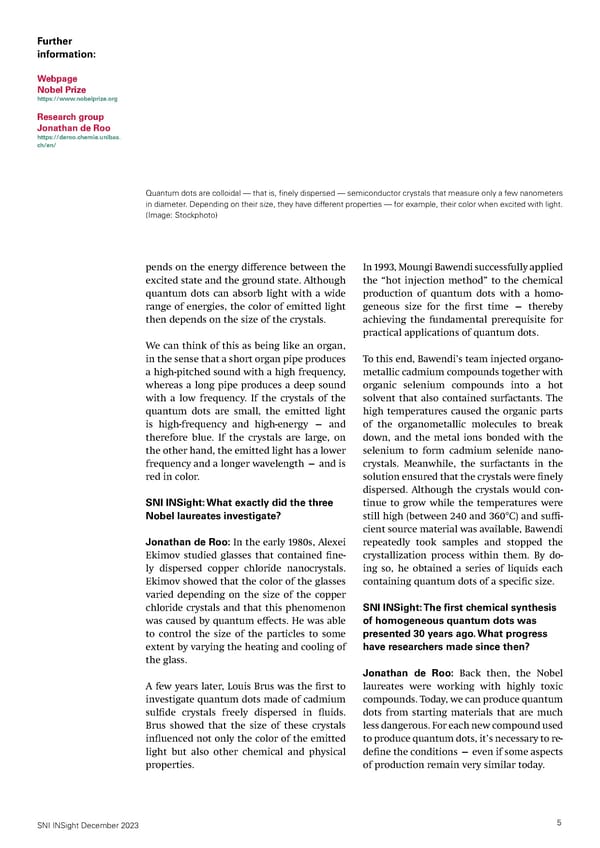
In the last few decades, researchers have massively in- In the future, quantum dots or nanocrystals may also play creased the quantum e昀케ciency of quantum dots. This a key role in medical applications — for example, in order was initially around 5% — in other words, it took 20 to visualize certain tissues. This is another focal point of photons of excitement to produce one photon of emitted our research. light. In modern quantum dots, the e昀케ciency stands at almost 100%. In part, this improvement was achieved by SNI INSight: Does your team also work with encasing the nanocrystals in an inorganic shell — like an quantum dots? onion having di昀昀erent layers. Jonathan de Roo: We don’t work with quantum dots, It is also important to adjust the reaction conditions so but we do use non-toxic colloidal nanocrystals made of that particles reach the target size at the end of the reac- zirconium and hafnium oxide. These are close relatives tion. To obtain small quantum dots, I can obviously take of quantum dots and are produced in a similar manner. my samples right at the start of the reaction and halt crystal growth — but then I lose most of the reagents. SNI INSight: What applications are you exploring The aim is to choose components and conditions with a for these nanocrystals? view to maximizing yield by making optimum use of the starting materials. This is another area where researchers Jonathan de Roo: We want to use the nanocrystals for have made considerable progress. diagnostic imaging. SNI INSight: What are quantum dots used for? In a project with colleagues from Ghent University Hos- pital (Belgium), we’re investigating whether the crystals Jonathan de Roo: Today, quantum dots are used in nu- can be used to boost soft-tissue contrast in X-ray exam- merous areas. For example, they are responsible for the inations. By doing so, we hope to pave the way for the brilliant colors in QLED televisions, where blue light is clear identi昀椀cation of “sentinel lymph nodes” in breast emitted by a gallium nitride light source and then con- cancer patients during surgery. To this end, the nanocrys- verted into green and red by the various quantum dots. tals are injected into the tumor, the liquid containing the These three primary colors can then be combined to pro- nanocrystals 昀氀ows through the lymph system to the 昀椀rst duce the full color palette. lymph node in the armpit, and this sentinel lymph node becomes visible in the X-ray image. As the solution carries In QLED lamps, quantum dots convert colors more e昀케- a dye, the surgeons can then visualize the sentinel lymph ciently than is the case with traditional LEDs, although nodes for removal during surgery. these QLED lamps are not yet commercially available. It is 昀椀rst necessary to improve the stability of the quantum In an SNI project, we’re working with colleagues from dots because, unlike a TV screen, an LED lamp becomes the PSI in order to use our nanocrystals to spot rejection very hot and can therefore cause the quantum dots to at an early stage in transplant patients. First, we equip “die o昀昀.” the nanocrystals with certain antibodies that bind spe- ci昀椀cally to immune cells. Then, if we add our antibody The nanocrystals from the de Roo team can be used to produce detailed images of even the 昀椀nest blood vessels in the gills of a zebra昀椀sh. (Image: Department of Chemistry, University of Basel) SNI INSight December 2023 6
nanocrystals to transplanted organ tissue obtained in a biopsy, the antibodies will bind to any immune cells. This allows us to determine whether a large quantity of immune cells are present in the tissue — which would point to the initial stages of rejection. SNI INSight: What challenges affect the production of nanocrystals? Jonathan de Roo: The oxide nanocrystals that we’re investigating are even harder to produce than quantum dots. Zirconium and hafnium carry a multiple positive charge, and their oxides are di昀케cult to produce because they have strong bonds that are not easily broken. At the same time, however, breaking bonds is a prerequisite for repairing defects in the crystals. Once they are produced, the crystals are extremely stable. We’re also studying complex shells of the crystals — Producing nanocrystals of uniform size is the prerequisite for putting which resemble layers of an onion — to further optimiz- them to use. (Image: Department of Chemistry and Nano Imaging Lab, ing their properties. On top of that, we’re working on University of Basel) producing oxide clusters, which are even smaller than nanocrystals and, above all, atomically precise — unlike the nanocrystals. In any case, there’s plenty of work to do and we still have numerous ideas about how we can provide various colloi- dal nanocrystals for di昀昀erent applications. Jonathan de Roo’s group is investigating hafnium/zirconium oxide nano- crystals (zirconium core and hafnium shell) for use in diagnostic imaging. (Image: Department of Chemistry, University of Basel) SNI INSight December 2023 7
PSI-Impuls Award Further information: Prize awarded to Thomas Mortelmans The Paul Scherrer Institute (PSI) and the PSI-Impuls Association have PSI-Impuls Award https://www.psi.ch/de/psi-im- presented former SNI doctoral student Dr. Thomas Mortelmans puls/psi-impuls-preis with the PSI-Impuls Award. Mortelmans received the prize, which is Article on Thomas presented every two years for the best application-oriented doctoral Mortelmans’ PhD dissertation dissertation at the PSI, for his dissertation on the “Development of a https://nanoscience. unibas.ch/en/news/details/ neues-prinzip-fuer-antikoerper- tests-thomas-mortelmans-be- nano昀氀uidic particle size sorter and its biomedical applications.” kommt-den-von-sensirion-ge- sponsorten-swiss-nanotechnol- ogy-phd-award/ In his doctoral dissertation, which was fund- Video on the ed as an SNI PhD School project, Mortelmans scientific approach developed a new functional principle for a https://youtu.be/7VKskNZCoMc rapid COVID-19 test that can also be used to Video with Thomas detect other viruses such as in昀氀uenza A or to about the SNI PhD determine the status of the disease. School https://youtu.be/9dqX_vimmcY Mortelmans carried out his work at the Paul Scherrer Institute in Dr. Yasin Ekinci’s group. In 2022, he previously received the Swiss Nan- otechnology PhD Award, which was launched by the Swiss MNT Network and sponsored by Sensirion, for a publication describing the functional principle of the micro昀氀uidic test in the journal ACS Applied Nanomaterials. Mortelmans now works as a device scientist at Johnson & Johnson in Scha昀昀hausen. “Our warmest congratulations on this well-earned award!” Thomas Mortelmans received the PSI-Impuls Award. (Image: PSI) SNI PhD School https://nanoscience.unibas.ch/ SNI PhD School en/forschung/phd-programm/ Applications still open Young researchers still have until December 31, 2023, to apply for the projects announced at the SNI PhD School. Further information: https://nanoscience.unibas.ch/en/forschung/phd-programm/ 8 SNI INSight December 2023
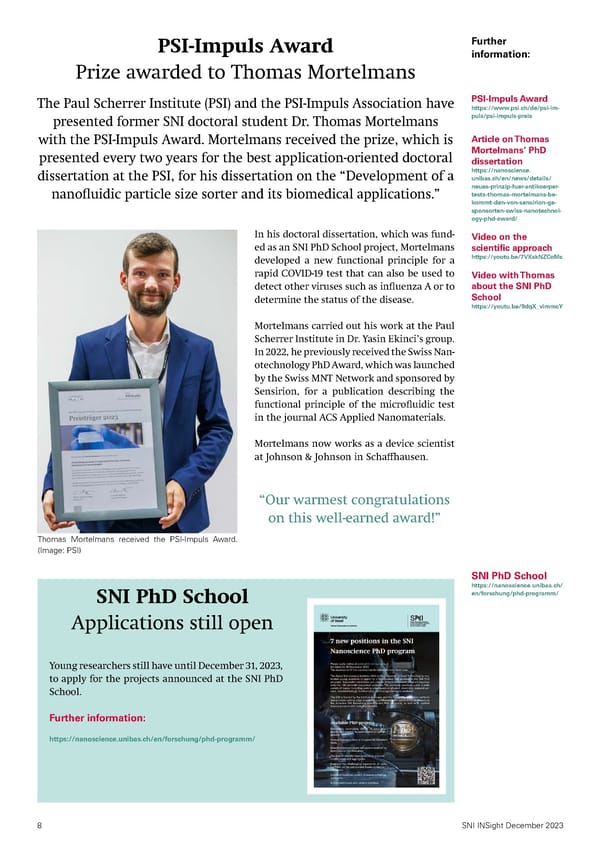
Nano Image Award 2023 Congratulations to the winners and thanks a lot to all participants! Series of talks Boundaries on nanosciences in the nanosciences In collaboration with Volk- The latest edition of UNI hochschule beider Basel, NOVA is all about how bor- the SNI is organizing a ders bind, divide and create series of lectures on the obstacles. topic of “Nanosciences — interdisciplinary into We contributed a listicle the future.” Using 昀椀ve on boundaries in the nano- examples from current re- sciences, of which you can search, scientists from the read a longer, slightly more SNI network will demon- detailed version here. strate the potential of the nanosciences. Complete issue of UNI NOVA Further information and registration Borders SNI INSight December 2023 9
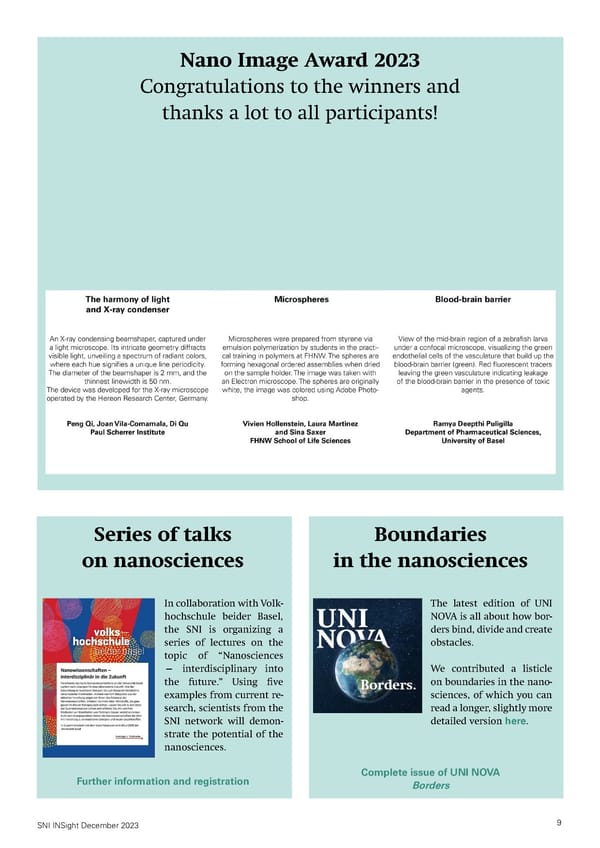
Passionate about microscopy and technology Markus Dürrenberger receives honorary membership of the SNI At this year’s Annual Event, Dr. Markus Dürrenberger received honorary SNI mem- bership in recognition of his extraordinary commitment to microscopy and for setting up the Nano Imaging Lab. Dürrenberger is not only an expert in all kinds of microscopes, but also an enthusiastic teacher and an outstanding technician who has brought numerous inventions to the market, as we learn in our interview. Biology was the right choice When Markus Dürrenberger’s father urged him to study molecular biology at the Biozentrum in Basel, over 40 years ago, the conversation opener at the Dürrenberger household presumably went something like this: “Molec- ular biology or you can fund yourself!” After completing his Matura (high-school diploma), Dürrenberger had ini- tially started a degree in power engineering but quickly realized that it wasn’t the right course for him. It was then that his father was able to help, with his strong sense of where his son’s strengths and preferences lay. Even as a child, Markus was always outside playing with his magnifying glass, and at school he was fascinated with natural cycles, microscopes and the life that could be found within a water droplet. “Luckily, I wasn’t given much choice in the matter,” At this year’s Annual Event, Markus Dürrenberger (left) was awarded laughs Markus. “But then I thoroughly enjoyed studying honorary SNI membership by SNI Director Martino Poggio. biology.” A particular fascination with viruses led him to research the development cycle of the Escherichia virus T4, a bacteriophage that infects the intestinal bacterium Escherichia coli both for his diploma thesis and later doc- “That was a stroke of luck, because we received 5% of toral dissertation. As these viruses are only visible under Lowicryl’s turnover toward our research for a period of 20 an electron microscope, Markus developed a passion for years,” says Markus Dürrenberger. “Later, at the Maurice these complex instruments, which allow detailed imag- E. Müller Institute, we added bone meal to the plastic to ing of even the smallest and 昀椀nest structures. develop a bone cement that’s still used in implants today. Successful plastic development This cement is also found in plastic dental 昀椀llings, as we In those days, when it came to embedding the infected used it to develop various 昀椀llings in collaboration with bacterial cells for examination using electron microscopy, the dental institute later in my career.” what Markus lacked was an ideal type of plastic that would Career moves before coming to Basel polymerize and therefore harden in the examination These developments took place while Markus was work- conditions of -100°C under exposure to UV light, allowing ing as a research assistant and head of the Center for Mi- him to prepare sections. As part of his work in Professor croscopy (ZMB) at the Maurice E. Müller Institute, which Eduard Kellenberger’s group at the Biozentrum, Markus was based at the Biozentrum of the University of Basel. therefore developed a biocompatible plastic — which was subsequently commercialized by the company Lowi (Ger- Prior to that, he had already gained some experience in many) under the brand name Lowicryl. the USA and at the University of Zurich: In 1988, imme- SNI INSight December 2023 10
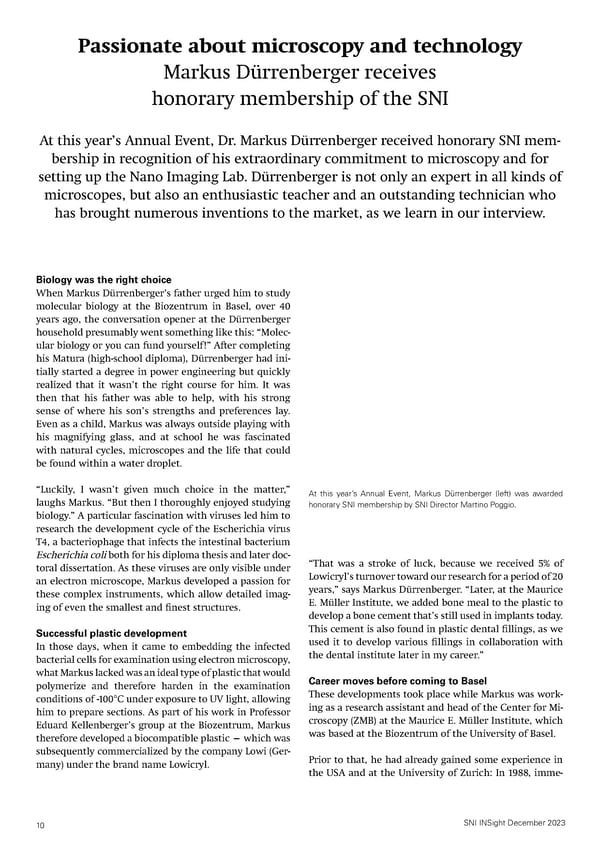
Further information: Nano Imaging Lab https://nanoscience.unibas.ch/ en/services/nano-imaging-lab/ Markus Dürrenberger is not only an expert in all kinds of microscopes, but also an enthusiastic teacher and an outstanding technician. diately after completing his doctoral disser- Since then, the NI Lab has become an import- tation, Markus spent a year at the Scripps ant pillar of the SNI. Thanks to the outstand- Research Institute in La Jolla (California, USA) ing work of the whole team within the SNI in order to share his experience in the 昀椀eld network and beyond, it is now a sought-after of plastics processing in microscopy. “I didn’t partner for all questions relating to imaging particularly like it there, mostly because of and analysis. the working environment and conditions, and I quickly applied to the University of Markus worked hard from the outset to re- Zurich with a view to creating a service de- new the NI Lab’s infrastructure, making sure partment for electron microscopy,” Dürren- it was 昀椀t for the future by the time of his re- berger recalls. tirement in 2023 and providing his successor, Dr. Marcus Wyss, with ideal conditions as he Then, after four successful years in Zurich, took up his new role. “When I retired in 2023, Professor Ueli Aebi brought Markus Dürren- all of the instruments were under 10 years berger back to Basel in 1993, o昀昀ering him a old. Thanks to an excellent new transmission position at the Maurice E. Müller Institute electron microscope, the NI Lab can fully in order to set up the Center for Microsco- meet the needs of materials science,” he says. py (ZMB) as a service platform for biological research and analyses. “It was a great time,” An enthusiastic tinkerer and teacher Markus recalls. “We had just about every In the interview, it quickly becomes clear kind of microscope that existed back then. how passionate Markus is about microscopy The highlight was the world’s fastest confo- and how fascinated he was with the technical cal microscope, operating at 240 frames a aspects of his work. Throughout his career, second.” he was never content simply to apply ex- isting equipment or methods — as soon as Part of the SNI team since 2016 he had mastered a machine’s operation, he Due to restructuring measures, the ZMB was would set about modifying, improving and dissolved in 2016. Markus and part of his expanding it. team were incorporated into the Swiss Na- noscience Institute (SNI) in the form of the For example, cooling systems that he devel- Nano Imaging Lab, where they would devote oped for the microscopes were subsequently more of their time to questions relating to adopted by the manufacturers — and there materials science. are also preparation machines that are based SNI INSight December 2023 11
on his previous work and innovations. Moreover, he per- Still not bored sonally built 100 units of a “glow discharger” – a device Even though he is now retired and those tasks fall to that uses plasma to make surfaces hydrophilic – and dis- someone else, Markus nevertheless remains very active. tributed them to colleagues around the world. “I always For the SNI, he does some work with Museum Burghalde loved overcoming a technical challenge to make our in Lenzburg on an hourly basis in order to integrate as- work easier — and, of course, I always enjoyed excellent pects of the nanosciences into the permanent exhibition. support from the mechanical and electrical workshop,” In addition, Markus continues to play an active role in the says Markus. pension fund of Basel-Stadt and is running as a candidate for its board of directors. Another of Markus’s passions is teaching. Generations of medical and biology students have completed his three- He also has a family as well as various hobbies. His four week microscopy block course and still remember it adult sons and partner of many years, Dominique, are fondly today. In 2022, he found himself on the operating delighted that he can now spend more time with them — table at the University Hospital Basel following an acci- in the mountains, for example, or at sea to dive. After all, dent in the mountains. The operating surgeon smiled at water — either as snow or in liquid form — is another of him and said, “I know you,” explaining that he had taken his passions, and he was once Swiss champion of the 100 the microscopy block course with him many years ago m breaststroke. And anyone who knows anything about and still had vivid and positive memories of it. Markus Dürrenberger knows that his motorcycle is never in one place for long. “We would like to thank Markus for his dedication over the years and congratulate him on his honorary membership. We are delighted that he will maintain his links with the SNI network as a member.” Nano Fabrication Lab The service unit is growing In November 2023, two new members of sta昀昀 joined the team of the Nano Fabrica- tion Lab (NF Lab): Juri Herzog and Xavier Wildermuth will now support Dr. Gerard Gadea and Arnold Lücke in their work. Together, the four-person team will further expand the portfolio of services in the 昀椀eld of nanofabrication. Founded in summer 2022, the NF Lab provides compre- time basis (60%) and are looking forward to tackling new hensive nanofabrication services and support to research challenges in the world of nanofabrication. groups and partners from industry. To strengthen the group and to meet rising demand, additional support Herzog initially completed an apprenticeship as a watch- will now be on hand for Dr. Gerard Gadea, head of the maker before embarking upon a master’s program in mi- NF Lab, and Arnold Lücke, who was previously the sole cro and nanotechnology while working at Oris. A change technician. to the CSEM followed, where Juri Herzog completed the master’s thesis before working as a technician for nine Juri Herzog and Xavier Wildermuth joined the NF Lab years. By studying for a Certi昀椀cate of Advanced Studies team on November 1, 2023. Both are employed on a part- (CAS), Juri gained deeper insights into key topics such as SNI INSight December 2023 12
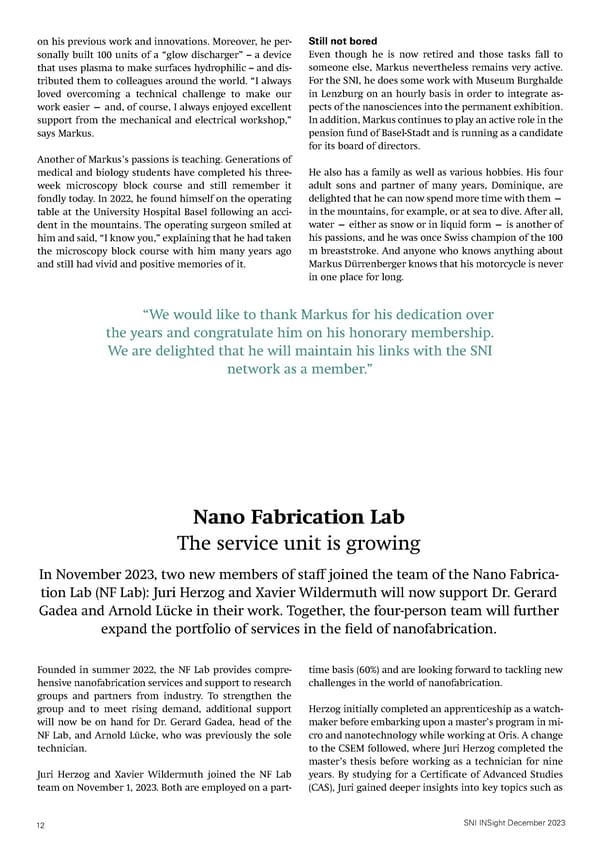
Further information: Nano Fabrication Lab https://nanoscience.unibas. ch/en/services/nano-fabrica- tion-lab/ The Nano Fabrication Lab is now supported by a team of four. They’re all looking forward to the many new challenges ahead in the 昀椀eld of nanofabrication. From left to right: Gerard Gadea, Arnold Lücke, Juri Herzog and Xavier Wildermuth. the environment and development, putting this knowledge to use in a temporary role at a major NGO. “I have wide-ranging interests and am delighted at the opportunity to con- tinue learning and taking on new challenges. Beginning a role at the SNI marks another exciting step in my life,” says Herzog. Xavier Wildermuth studied nanosciences in Basel and wrote his master’s thesis at Dr. Thomas Braun’s lab. For his master’s research, he developed part of a modular micro昀氀uidic system that can be used to stabilize samples The Nano Fabrication Lab team works in the clean room prepared for cryo-electron microscopy. at the Department of Physics at the University of Basel. Wildermuth has broad experience in the 昀椀eld of microscopy and has shown himself capable of mastering new tasks quickly and taking on responsibility — for example, as deputy “We’d like to welcome the two managing director of an events agency. “I’m new members of sta昀昀 to the delighted to have this opportunity to bring my thirst for knowledge and my open-mind- Nano Fabrication Lab and wish edness to the world of nanofabrication,” says them well in their new roles.” Wildermuth on this new challenge. SNI INSight December 2023 13
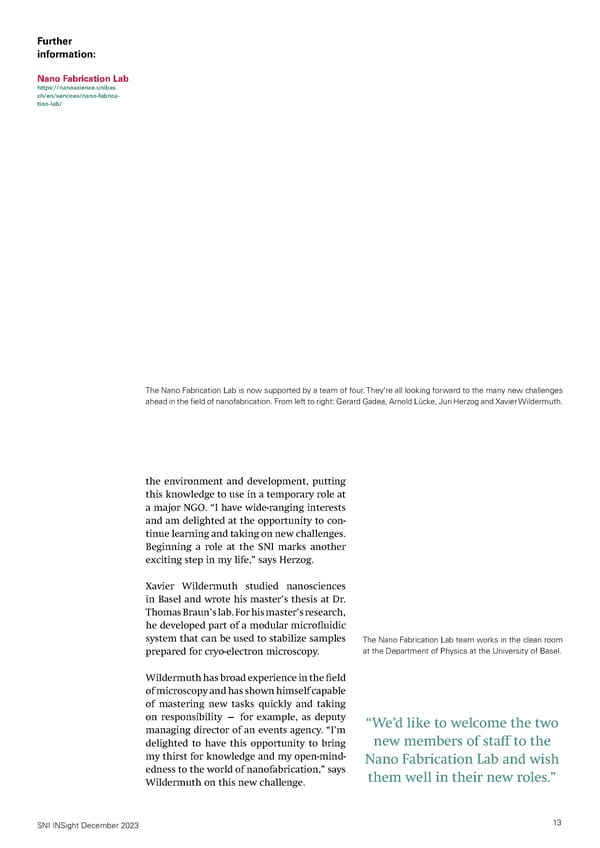
Further Back to her roots information: Video Former nanoscience student Anne Géraldine https://youtu.be/4nbXd3jKkZ0 Uni News Guex is returning to Basel as a professor https://www.unibas.ch/ en/News-Events/News/ Uni-Info/New-assistant-profes- sor-of-oral-implantology.html From 2024, the Straumann Assistant Professor Anne Géraldine UZB Guex will become a member of the SNI network. The unusual https://www.uzb.ch/ thing about this appointment is that Guex was part of the SNI at forschung/mitarbeitende-for- schung/ the time of its founding, when she was a student of the nano- sciences. Now, she will be supervising nanoscience students herself and will play an active role in SNI-supported research projects, focusing on research into oral implantology. Thanks to her previous work in areas such as tissue engineering and bioma- terials, she is ideally equipped to develop new materials for subse- quent use in clinical practice for the bene昀椀t of patients. Since April 2023, Géraldine Guex has been Assistant Professor of Oral Implantology at the University Center of Dental Medicine Basel (UZB). After completing school in Fribourg, Anne and I felt like I was in the right place, because Géraldine Guex initially wanted to study I’d always enjoyed tinkering with things and medicine and attended the Bachelor’s in- doing my own research,” she recalls. formation day at the University of Basel to 昀椀nd out more about medical studies there. A good start in the nanosciences She then realized that medicine lacked a re- Géraldine therefore enrolled on the nano- search component and that her gut instinct sciences program in 2003, becoming part of to study medicine was not exactly correct. the second-year group of students on this de- With that in mind, she also sought out in- manding, interdisciplinary course of studies. formation about the nanosciences degree The program had only been founded in 2002 program, which was completely new at the within what was then the National Center of time. “The nanoscience stand appealed to Competence in Research (NCCR) Nanoscale me immediately. The people were really nice, Science. Looking back, she particularly valued 14 SNI INSight December 2023
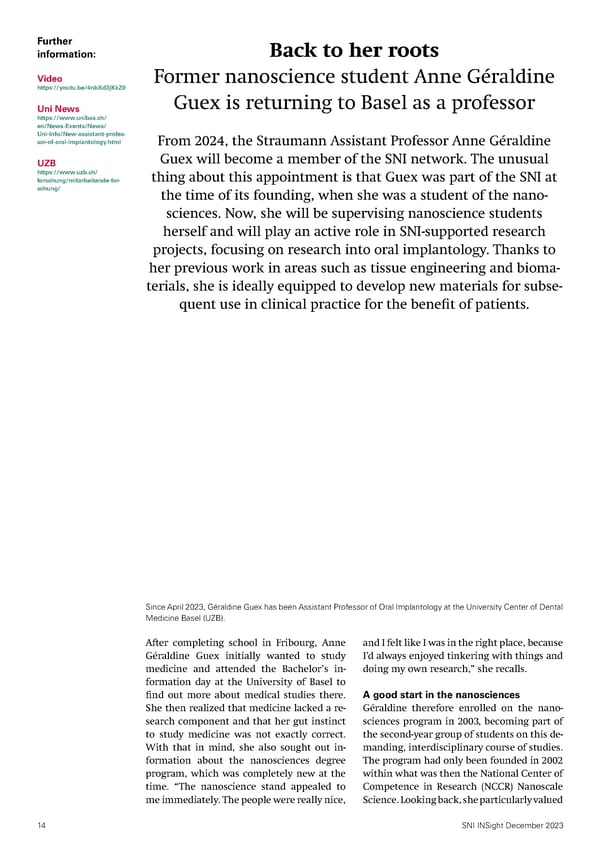
the sense of team spirit and mutual support. “We used to meet for a ‘constructive cake session,’” she says. “This was a way of combining exercises relating to the lectures with something fun.” The relatively relaxed relationship with the professors is also something that she still remembers fondly. “Although everything was new, and a bit chaotic at times, we were accepted and integrated wherever we went and also enjoyed a great deal of freedom.” A focus on chemistry and biology From the outset, she was primarily interested in questions relating to chemistry and biology. With that in mind, she completed her master’s thesis on tissue engineering in the group led by Professor Ivan Martin, head of the De- partment of Biomedicine at the University of Basel. Since then, she hasn’t lost her interest in — or fascination with — the production of arti昀椀cial tissue. Whereas her master’s thesis explored methods for cultur- ing cartilage in the laboratory, her subsequent doctoral Supervising students from different disciplines is one of Géraldine dissertation at the University of Bern focused on muscle Guex’s core tasks. cells. “We developed a matrix that was suitable for using mesenchymal stem cells originating from the bone mar- row as an implant following a heart attack,” says Géral- dine. She continued this research for another year as a orientation of cells within a hydrogel. In another area of postdoc at the Swiss Federal Laboratories for Materials research, Géraldine looked at the mechanical simulation Science and Technology (Empa) and then spent two years of certain cells in the immune system (macrophages) and studying conductive polymers for bone tissue engineer- stem cells from the bone marrow. This work primarily ing at Imperial College London as part of an SNSF Swiss entailed using in vitro models to examine how exercise Postdoctoral Fellowship. a昀昀ects the healing process following a bone fracture, for example. “I learned to communicate with Returning to Basel as an endowed professor experts from very di昀昀erent disciplines Despite choosing to study the nanosciences instead of and to respect and bene昀椀t from medicine, Géraldine has subsequently turned her atten- di昀昀erent ideas.” tion to medical topics over the course of her career. Ac- cordingly, the obvious next step was to continue in this Prof. Géraldine Guex vein. In 2022, she therefore applied to the University of University Center of Dental Medicine Basel (UZB) Basel for an assistant professorship in oral implantology sponsored by the Basel entrepreneur and honorary doc- tor Thomas Straumann. She ultimately prevailed over her competitors and took up the professorship at the Univer- Various methods for better healing sity Center for Dental Medicine Basel (UZB) in April 2023. After two years in London, Géraldine returned to Empa to research antibacterial wound dressings. There, her “Basel is, of course, very attractive as a city — and bioma- investigations focused on various peptides and gallium terials and tissue engineering are subject areas that I’ve complexes as potential active substances for tackling been working on for years. Although I had no previous bacterial infections. In collaboration with the Laboratory links with dental medicine, I’m very familiar with organ- of Organic Electronics at Linköping University, she also ic and inorganic materials and the biological principles evaluated a controlled proton pump that can be used to needed for the projects,” says Géraldine Guex. precisely regulate the pH value in wounds and thus to achieve an ideal, slightly acidic environment for wound Setting up a group healing. Géraldine is currently supervising a master’s student and two doctoral students from the 昀椀eld of dental medicine, For Géraldine, this was followed by three years as a re- but the group will continue to grow. For example, she is search scientist at the AO Research Institute in Davos, now in a position to take on a doctoral student, a biology where she worked with the start-up mimiX and investigat- lab technician and a postdoc. With this team, Géraldine ed how acoustic waves in昀氀uence the three-dimensional hopes to develop complex, three-dimensional in vitro SNI INSight December 2023 15
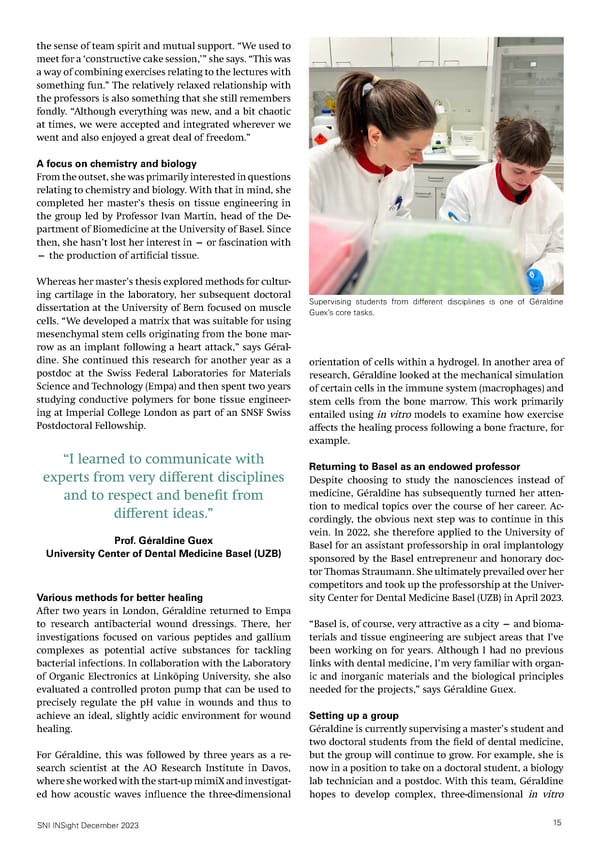
models consisting of bone tissue in the lower section and “The project is primarily about soft tissue in the upper section, for example. Models of exploring the interactions between this kind would allow researchers to investigate how a dental, bone or tissue implant interacts with the body materials and cells using new methods, and help to improve our understanding of wound heal- and about understanding these ing processes. They would also make it easier to optimize interactions on the molecular level.” the surface properties of dental implants using micro and nanofabrication. Prof. Géraldine Guex With the help of her group, Géraldine is also planning to University Center of Dental Medicine Basel (UZB). investigate personalized treatment methods in relation to oral implants. “The methods used in oral implantology today are primarily optimized for healthy patients,” she explains. “If someone with diabetes and impaired wound Together with UZB colleague PD Dr. Nadja Rohr, Géraldine healing receives an implant, however, standard measures is also participating in a Nano-Argovia project from 2024 often fail to deliver the desired results.” In this regard, onward. Working with project partners from the FHNW tissue cultured from the patient’s own stem cells, for School of Life Sciences and the Straumann Institute, the example, could potentially compensate for the de昀椀cits in scientists are investigating how to create the optimum the body’s own wound healing processes and signi昀椀cant- surface of zirconia dental implants for e昀昀ective healing. ly improve the implant’s chances of long-term success. Interdisciplinary education pays off Together with Professor Michael Nash of the Department Géraldine is looking forward to the work that lies ahead of Chemistry, Géraldine will be supervising a doctoral dis- and to collaborating with researchers from wide-ranging sertation at the SNI PhD School from 2024 onward. This disciplines. It helps that she has already been “immersed research aims to investigate how the formation of bone in an interdisciplinary environment” during her degree. cells is a昀昀ected by synergistic e昀昀ects of nanosurfaces and “I learned to communicate with experts from very di昀昀er- peptides immobilized on polymer substrates. “We want ent disciplines and to respect and bene昀椀t from di昀昀erent to understand the in昀氀uence of surface structure on pro- ideas,” she explains. tein or peptide absorption and how a speci昀椀c interface a昀昀ects the di昀昀erentiation of bone-forming stem cells. The Géraldine left Basel with a master’s degree in nanoscienc- project is also primarily about exploring the interactions es in 2008 and has now returned as a professor. She says between materials and cells using new methods, and she would choose to study “nano” again today, as it has about understanding these interactions on the molecular allowed her to realize her childhood dream: carrying out level,” explains Géraldine. research into medical issues. “We’re delighted to welcome her to our network as a project leader, and we look forward to her participation in exciting SNI projects.” Géraldine Guex is looking forward to the two SNI-funded projects that she will participate in starting in 2024. SNI INSight December 2023 16
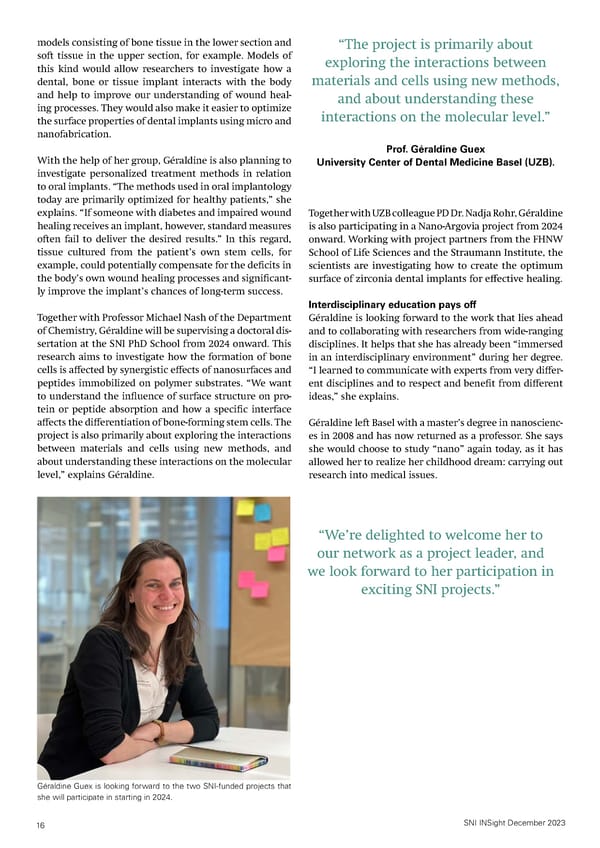
Projects as part of the Quantum Transitional Call Participation by SNI members The second half of 2023 saw the launch of four quantum research projects with the participation of SNI members. These projects had been announced as part of the Quantum Transitional Call by the Swiss National Science Foundation (SNSF). For researchers from the Department of Physics at the University of Basel, the support will allow them to continue with their various lines of research, which were previously part-supported by EU funding programs. Although the funding is no substitute for participation in the European programs, it goes some way toward mitigating the impact of exclusion for Swiss research groups. On the road to quantum networks Quantum dots and atomic vapor cells Numerous research groups worldwide are investigating Richard Warburton’s group has already shown that semi- quantum networks with a view to the wide-ranging appli- conductor quantum dots can emit single photons at a high cations they promise, such as the interlinking of quantum rate and with excellent spectral purity. In the SQnet proj- computers or quantum sensors, secure quantum commu- ect launched in September 2023, the researchers will now nication, or the investigation of many-particle systems. use novel quantum dots that emit photons of a speci昀椀c The construction of complex quantum networks, how- wavelength that is compatible with rubidium atoms. For ever, represents a major technological challenge that is the quantum memory, the researchers are using atomic yet to be overcome. vapor cells developed by the Treutlein team. “These are glass bulbs 昀椀lled with rubidium gas that, unlike other Combined expertise quantum memories, also work at room temperature and A powerful platform for such quantum networks is don’t need to be intensely cooled in a cryostat. This is vital being developed by researchers led by Basel professors when it comes to upscaling the technology for a complex Philipp Treutlein and Richard Warburton together with network,” explains Treutlein. colleagues from the Swiss Center for Electronics and Mi- crotechnology (CSEM) in Neuchâtel. The researchers have already performed a proof-of-prin- ciple demonstration with a quantum memory, but they The researchers are using a platform that appears to o昀昀er will need to miniaturize the technology in order to build feasible upscaling from a technological perspective. For a more complex network. The glass cylinders used so each node point in the network, the platform allows re- far are a few centimeters in size and are individually searchers to combine a source of single photons, which produced by a glassblower. Thanks to the expertise of transport information, with a single-photon memory. CSEM colleagues in miniaturization, nanofabrication and The photons are placed in a quantum mechanical super- nanophotonics, it will be possible to produce quantum position state, with one part being stored in the memory memories of a signi昀椀cantly smaller size and to automate while the other part relays quantum information to the the production process. next node points, in order to generate entanglement within the network. Background information Within the international research program known as the announcement of the Quantum Transitional Call Horizon Europe, Switzerland is currently classed as a in 2022 with a view to allowing researchers involved non-associated third country, meaning that researchers in quantum research programs under Horizon Europe from Swiss research institutions have been excluded to continue pursuing their research projects. Five SNI from many EU research programs. Switzerland’s State members from the Department of Physics at the Uni- Secretariat for Education, Research and Innovation has versity of Basel are involved in successful projects that therefore mandated the Swiss National Science Foun- began in the second half of 2023 and are set to receive dation to develop a transitional solution, leading to funding over a period of four years. SNI INSight December 2023 17
Further information: Interview with the successful professors from the University of Basel: https://www.unibas.ch/de/Uni- versitaet/Administration-Ser- vices/Vizerektorat-Forschung/ Grants-Office/Grants-Office- News/Grants-Office-Newslet- ter-2023-7/Quantum.html Research group Philipp Treutlein https://atom.physik.unibas.ch/ en/research/ Research group Richard Warburton At each node point in the quantum network, the aim is to link a photon source with a quantum memory. The information https://nano-photonics.unibas. is then transmitted using entangled photons. (Image: Department of Physics, University of Basel) ch Contribution “Our partners at CSEM have managed to pro- in December 2023, two PhD students and Physics World duce 700 of these vapor cells on a wafer,” says one postdoc will advance the Poggio Lab’s https://physicsworld. com/a/rubidium-va- Treutlein. “We can use these tiny quantum promising research into scanning probe mi- pour-makes-a-good-quan- tum-memory/ memories to make the individual nodes of croscope imaging. the network signi昀椀cantly smaller, so that Research group we can potentially build larger networks. The researchers will study superconducting Martino Poggio It may also be possible to equip individual qubits — as these are being used as a prom- https://poggiolab.unibas.ch nodes with multiple vapor cells and thus to ising platform for realizing a quantum com- Research group increase the processed data volume — but puter by large companies such as Google and Patrick Maletinsky there’s a lot of research to do before we reach IBM. Working designs with tens to hundreds https://quantum-sensing. that stage.” Two doctoral students and one of qubits already exist, but the much larger physik.unibas.ch/en/ postdoc will push ahead with this work at the numbers needed for a working quantum Department of Physics. computer require a better understanding Research group of defects and vulnerabilities — in terms of Andrea Hofmann Wavelength adjustment both the material and the design of the super- https://hofmannlab.physik. unibas.ch/en/ Another challenge facing the researchers conducting circuits. are the glass 昀椀bers that connect the nodes. Transmitting data over large distances will Tracking down defects require the wavelength of the photons to be The superconducting qubits studied by the within the range used by existing telecoms Poggio team are largely fabricated by col- 昀椀ber — which is not the case for the spectral leagues at ETH Zurich from thin layers of lines studied so far. In the scalable system, aluminum and niobium or tantalum. The the researchers must therefore incorporate Poggio group uses highly sensitive scanning a photonic chip that allows them to convert probe imaging with superconducting quan- the wavelength. This then combines the red tum interference devices (SQUIDs) at the photons of the existing system with an infra- probe’s tip to identify, localize and ultimate- red pump laser so that they generate photons ly contribute to solving problems that arise suitable for telecom networks. Every single when the number of qubits is scaled up. photon is converted into exactly one photon of the required wavelength. Currently, researchers from the Department of Physics study the qubits in a cryostat at Sensors for superconducting 300 millikelvin. “With the help of the Super- quantum bits SQUID project, we will be able to upgrade For Professor Martino Poggio’s group, the our cooling system so that we can cool them funding received will allow the continuation down to temperatures of 10 millikelvin,” of research in the 昀椀eld of quantum sensors reports Dr. Floris Braakman, who is respon- for superconducting quantum bits. Starting sible for the project in the Poggio team. 18 SNI INSight December 2023
“The superconducting qubits normally operate at these bust sensors. Each of the NV centers contains six orbiting low temperatures. So, it’s important for us to be able to electrons, whose intrinsic angular momenta (spins) react work with our scanning SQUID microscope in these con- very sensitively to electric and magnetic 昀椀elds in their ditions.” In addition, the researchers plan to implement environment, and which together behave like a tiny mag- a high-speed microscope that can capture rapid changes. net. The electrons are excited and then emit individual photons, which deliver information about the spin state Over the next four years, the researchers will use these and therefore about the electric and magnetic 昀椀elds. methods to create spatial maps of material defects and to map magnetic 昀椀elds as well as current 昀氀ow and losses in For the envisaged temperature measurements, the re- the superconducting circuits. The data will help to bet- searchers are planning to use probes featuring a conical ter understand the mechanisms for the loss of quantum diamond tip with a diameter of only around 10 nanome- properties, known as decoherence, and to provide recom- ters at the point and numerous NV centers at the base. mendations for improved circuit design and the quantum Since diamond is an excellent conductor of heat, the tem- bit fabrication process. perature “felt” by the tiny tip in昀氀uences the interactions between electrons of the NV centers. The individual NV Rotation and temperature measurements centers are not particularly a昀昀ected by these interactions using diamonds — which is what makes them so robust in other applica- In recent years, tiny diamonds with defects known as tions. If numerous NV centers are combined, however, nitrogen-vacancy centers have become an established the thermal expansion of the diamond crystal can be used tool for the development of powerful, highly sensitive for temperature determination. Using the planned setup, quantum sensors for electric and magnetic 昀椀elds. Accu- the researchers expect to achieve a spatial resolution of rate temperature measurements can be obtained via the some 10 to 20 nm. spin of individual electrons orbiting within the vacancy centers, while rotation can be measured by analyzing the Electron spins o昀昀er only limited suitability for the accu- angular momentum of the atomic nuclei. rate detection of rotation. This is because they respond too sensitively to magnetic 昀椀elds, whereas the spins of In the ensQsens project, researchers from the Univer- atomic nuclei (nuclear spins) are much better suited to sity of Basel, the Swiss Center for Electronics and Mi- this application. Not only are these spins less sensitive to crotechnology (CSEM) in Neuchâtel and the Laboratoire external magnetic 昀椀elds, but they can also be addressed des Sciences des Procédés et des Matériaux (CNRS) will optically — as Maletinsky’s group was able to demon- develop quantum thermometers and rotation sensors of strate for the 昀椀rst time last year. With that in mind, the this kind. The researchers will also initiate the miniatur- group is working with the project partners to explore ization and integration of these sensors into housings the use of diamond nuclear spins as rotation sensors in on the centimeter scale. Launched in October 2023, the another subarea of the project. The aim is to integrate project will further promote the applicability and distri- these sensors into a compact housing in collaboration bution of quantum sensors. with the project partners at CSEM. In the future, this may lead to applications in the navigation and stabilization of The research will be carried out by two doctoral stu- self-driving vehicles or drones. dents and one postdoc in the group working under prin- cipal investigator Professor Patrick Maletinsky from the Qubits made of graphene Department of Physics. Teaming up with CSEM and the Professor Andrea Hofmann was a successful co-applicant CNRS, the researchers will pursue the use of ensembles in the GraQuaDotQb project. Led by Professor Thomas of nitrogen-vacancy centers (NV centers) as sensors in Ihn (ETH Zurich), this project will see Hofmann and her complementary lines of research. On the one hand, group investigate how quantum dots can be formed in they are using nuclear spin ensembles in diamonds coupled graphene layers. In collaboration with the re- to develop a novel rotation measurement device that searchers from ETH Zurich, Hofmann’s team will then could be used in portable navigation systems and could study these bilayer graphene quantum dots as substrates operate more accurately and more robustly than exist- for spin, valley or spin-valley qubits. ing rotation sensors. On the other hand, their research aims to produce a tiny thermometer based on electron Currently, however, Andrea Hofmann is immersed in an spin ensembles. This could have applications in areas even more exciting project, having become a mother in such as electronics. mid-October. Our congratulations and best wishes to her and her family! Use of electron and nuclear spins The researchers believe that the spins in diamonds are particularly promising, for they operate at room tem- perature and have already proven themselves to be ro- SNI INSight December 2023 19
Guest article Alexa Dani Looking back on INASCON 2023 A “journey” organized by students The journey of the International Nanoscience Student Conference (INASCON) began in Silkeborg, Denmark, in 2007 with a visionary idea: a conference organized by students for students. Since then, the meeting has traversed eight countries and attracted bachelor’s, master’s and PhD students from across Europe and beyond. This year, Basel hosted the conference for the third time from 22 to 25 August. Global collaboration Putting the “international” in INASCON, the event in Ba- sel in August 2023 brought together over 60 participants from 26 universities in 15 countries. Thanks to generous support from our sponsors, INASCON was able to wel- come not only doctoral candidates but also students, as well as numerous guests. It was very important to us that, thanks to 昀椀nancial support, all visitors were able to attend. Over three quarters of participants stayed at Hotel Odelya and made contacts extending well beyond the conference program. Our program The diverse group of participants in INASCON 2023 thoroughly enjoyed their time in Basel. (Image: Peter Dani) Under the motto “Make Nano Visible,” this year’s pro- gram culminated with fascinating talks by well-known scientists: Anne Géraldine Guex, Sabina Caneva and Patrick Shahgaldian shared their specialist knowledge and highlighted the importance of interdisciplinary ap- proaches in the biosciences. James Wootton from IBM Research Europe – Zurich brought a spot of humor to the conference with his talk on quantum error correction. In another highlight of INASCON, Clarice Aiello gave a pub- lic talk on quantum biology, captivating over 170 science enthusiasts and triggering the longest Q&A session of the conference. We were also privileged to welcome two Nobel laureates among our guests: Kurt Wüthrich, who Professor Morten Meldal at his Professor Clarice Aiello at her provided some insights into 60 years of research in the talk “Molecular Click Adventures public talk on the subject of quan- 昀椀eld of protein NMR, and Morten Meldal, who explained — A Leap from the Shoulders of tum biology. She explained how his groundbreaking work in the area of click chemistry Giants.” (Image: Tania Beringer) nature uses quantum processes and o昀昀ered us an insight into the Nobel Prize award cer- to achieve optimum operation emony. and how we can control these processes for therapeutic bene昀椀t. (Image: Tania Beringer) “Last week, I had the great pleasure of speaking before brilliant young minds at INASCON in Basel.” Professor Morten Meldal SNI INSight December 2023 20
The SNI-sponsored “Wickel昀椀sch” waterproof swim bag was a prized Another item on the agenda was the Enterprise Fair, which offered goody for Basel’s hot summer days and — with its bright red color — has participants an opportunity to make contact with leading industry ex- been spotted in the Rhine repeatedly since the conference. perts from various sectors of the nanosciences. The event served as a bridge between aspiring talents and the organizations shaping the nanosciences of the future. (Image: Tania Beringer) Our culinary o昀昀erings were just as varied as the scientif- ic discussions. From pizza to Mediterranean delicacies, there was something to suit all tastes — and gastronomic highlights included the surprise gelato break from Gelat- eria di Berna and our conference dinner at the Teufelhof hotel. On the lab tours, participants had the chance to get to know various research groups in the 昀椀elds of physics, chemistry and biology from the University of Basel and the University of Applied Sciences Northwestern Switzer- land (FHNW) in Muttenz. There was also an opportunity The organizing team in Basel: Elaine Schneider, Lukas Schneider, Timon for everyone to discover the city of Basel on a Foxtrail Flathmann, Alexa Dani, Luca Forrer, Rahel Kaiser, Mathias Claus and tour, as part of a visit to Museum Tinguely or under their Valerie Bendel. own steam — equipped with their waterproof swim bags. Our motto “Make Nano Visible” was well received by “For the organizing committee, the pro- bachelor’s, master’s and PhD students from across all disciplines, who presented their innovative research cess of planning INASCON over a period projects in fascinating talks and at an informative post- of almost 12 months presented us with er session. The prize for the best poster went to Fabian Scheidler from the University of Würzburg, and the prize repeated hurdles. With some stamina, for the best talk to Amir Nazemi from FHNW Muttenz. creativity and support from the SNI, we These two outstanding contributions were rewarded were able to overcome these hurdles as with cameras from our sponsor Nikon! a team and learned a great deal in the United in diversity process. We’re delighted that INASCON INASCON 2023 brought together brilliant minds from di昀昀erent areas of research, universities and cultures, not 2023 in Basel proved to be an education- only yielding new ideas and opportunities for semesters al and exciting experience for all!” abroad but also opening up potential career pathways and collaborations. With their di昀昀erent origins and goals, all Organizing team of the INASCON 2023 participants played a part in making nano more visible. INASCON 2024: Assembling the Future Further information: We’re now eagerly awaiting the next installment INASCON of INASCON, which will be held at the University of https://inascon.org/ Twente in Enschede, Netherlands. Under the motto “Assembling the Future,” INASCON 2024 promises to be another extraordinary milestone in research and innovation. SNI INSight December 2023 21
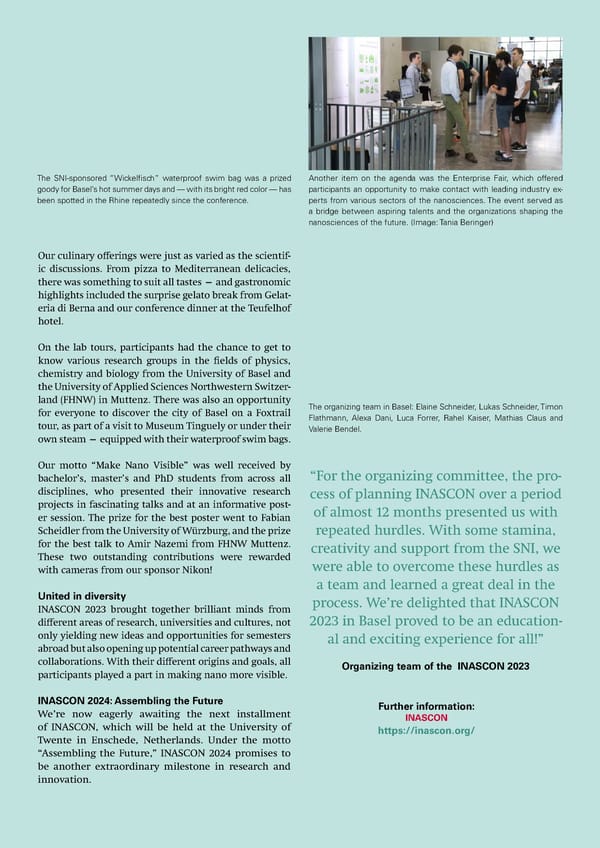
Further Support in the form of detailed imaging information: The Nano Imaging Lab is a popular destina- Nano Imaging Lab https://nanoscience.unibas.ch/ tion for high-school diploma projects en/services/nano-imaging-lab/ Matura theses The work of the Nano Imaging Lab team provides numerous https://nanoscience.unibas.ch/ en/services/nano-imaging-lab/ companies and research groups with valuable information as well publikationen/internships/ as support for wide-ranging research projects. A few times a year, however, high-school students have the chance to explore inter- esting research questions with the help of sta昀昀 from the NI Lab. In 2023, four Matura students worked on investigations at the lab as part of their high-school diploma projects. It all depends on the material As part of his high-school diploma (Matura) Antoine Schneider from Gymnasium Liestal project, Schneider examined two approved completed a project in which he investigated disinfectants and found that the wipe test whether the results of the standardized wipe doesn’t always ensure the elimination of test could be applied to other materials. This microorganisms on other materials used in test is required in Switzerland and the EU for operating rooms. With support from Profes- the approval of bactericidal surface disinfec- sor Marek Basler’s team at the Biozentrum, tants. Schneider used quantitative microbiological methods to show that the tested agents suf- Surface disinfection plays a key role in 昀椀ciently disinfected stainless steel and a PVC curtailing infections that are contracted by 昀氀ooring material in a wipe test and that the patients during medical treatment. Before a materials exhibited bactericidal properties new disinfectant is approved, its disinfectant even without being treated. In contrast, a properties are tested in a standardized wipe high-pressure laminate that the researchers test on a PVC surface. investigated did not meet the requirements. Scanning electron microscope images of standard PVC, high-pressure laminate (HPL), stainless steel and PVC 昀氀ooring reveal the different surface structures of the various materials. (Image: A. Schneider and Nano Imaging Lab, SNI, University of Basel) 22 SNI INSight December 2023
At the Nano Imaging Lab, analyses were to depict the samples as completely as possible. carried out using a scanning electron micro- Bader used freely available software (including scope and a 3D laser-scanning microscope Alicevision Meshroom, Agisoft Metashape and with the help of Susanne Erpel and Dr. Moni- OpenSFM) to generate digital raw models of the ca Schönenberger. The results indicated that samples, which he then improved and simpli昀椀ed disinfectability depends on surface structure. using various programs. To save material during Given that the high-pressure laminate has a the subsequent 3D printing, he hollowed out much smoother surface than the other ma- the models before embedding them in a stand terials, it may be that wettability and there- and 昀椀tting them with support structures. Lastly, fore disinfectability increase due to adhesive he successfully printed and postprocessed the capillary forces on corrugations, pores or models using a photopolymer printer. Bader was grooves in the stainless steel or PVC. actively supported in this work by Dr. Ludovit Zweifel from the Research Instrumentation Fa- Printed models for teaching cility of the Biozentrum. For his high-school diploma thesis, Yanick Samuel Bader from Gymnasium Liestal ex- Bader’s project demonstrated that photogram- plored how a three-dimensional reconstruc- metry is suitable for the reconstruction of 3D tion method known as photogrammetry can models from SEM images without any special produce 3D-printable models from scanning calibration, although the models are not suitable electron microscope (SEM) images. These for quantitative measurements. models can then be used as teaching aids in the natural sciences. Branched and species-specific In her high-school diploma project, Jana Egli Supervised by Daniel Mathys from the Nano from Gymnasium Oberwil investigated and Imaging Lab, Bader 昀椀rst produced SEM imag- compared the vein systems in bee, wasp and es of various objects. These images were in- bumblebee wings. tended to capture the various examples — a camera sensor, a normal fruit 昀氀y and a mutant The veins in wings play a signi昀椀cant role for these fruit 昀氀y — from various perspectives in order “hymenopterous” insects — that is, insects with membranous wings — by forming a network of longitudinal and transverse veins that contrib- ute to the structural stability of the wing. Nerves running through the veins relay important infor- mation from mechanical receptors that grow as tiny hairs on the wing surface. The veins also act as a route for transporting hemolymph, which not only supplies the animal with nutrients and 昀氀uid but also protects the wing from drying out. Egli examined 昀椀ve front right wings each from honeybees, common wasps and bu昀昀-tailed bum- blebees on a scanning electron microscope and then compared them with the left wings of each animal. By doing so, she found that the vein pattern does not vary signi昀椀cantly within a species, but that there are considerable di昀昀erences between the patterns for the three species. In the case of wasp wings especially, it is clear that the wing surface of the veins is ribbed, whereas the veins in bee and bumblebee wings have a smooth surface. Egli also used the images to show that an ani- mal’s two front wings are vertical mirror images of one another and that the size of the wings is Model of the head of a fruit 昀氀y with and without support- correlated with the size of the insect. ing structures, based on scanning electron microscope images. (Image: Y. S. Bader) SNI INSight December 2023 23
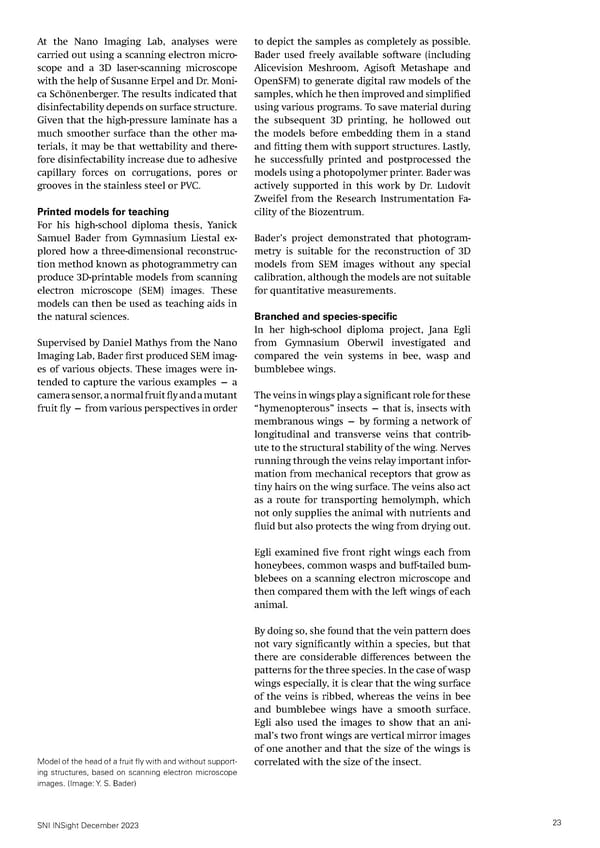
Vein patterns of a honeybee, a common wasp and a bumblebee. (Image: J. Egli and Nano Imaging Lab, SNI, University of Basel) Structure of the wing surface in the vein system of a honeybee, a common wasp and a bumblebee. (Image: J. Egli and Nano Imaging Lab, SNI, University of Basel) The “song” of the Jamaican field cricket termined their in昀氀uence on the frequency of the calling For his Matura thesis, Tim Zimmerli from Gymnasium song. Contrary to his hypothesis, he found that the width Münchenstein analyzed various in昀氀uences on the calling of the 昀椀le teeth had only a minor in昀氀uence on the domi- song of Jamaican 昀椀eld crickets. As part of this work, he nant frequency of the call. received support from the team of the Nano Imaging Lab, among others. “Working on the scanning electron Male crickets produce a calling song to attract females microscope was a real highlight of my by rubbing a special structure known as a scraper on one Matura project.” wing across a 昀椀le, with numerous teeth, on the other. Tim Zimmerli on the support he received In his project, which was supported by the Nano Imaging from Evi Bieler and Dr. Monica Schönenberger Lab, Zimmerli studied the number, structure and width of the Nano Imaging Lab of the 昀椀le teeth of a male Jamaican 昀椀eld cricket and de- The shrill bar with numerous teeth on a wing of the Jamaican 昀椀eld cricket is clearly visible. (Image: T. Zimmerli and Nano Imaging Lab, SNI, University of Basel) SNI INSight December 2023 24
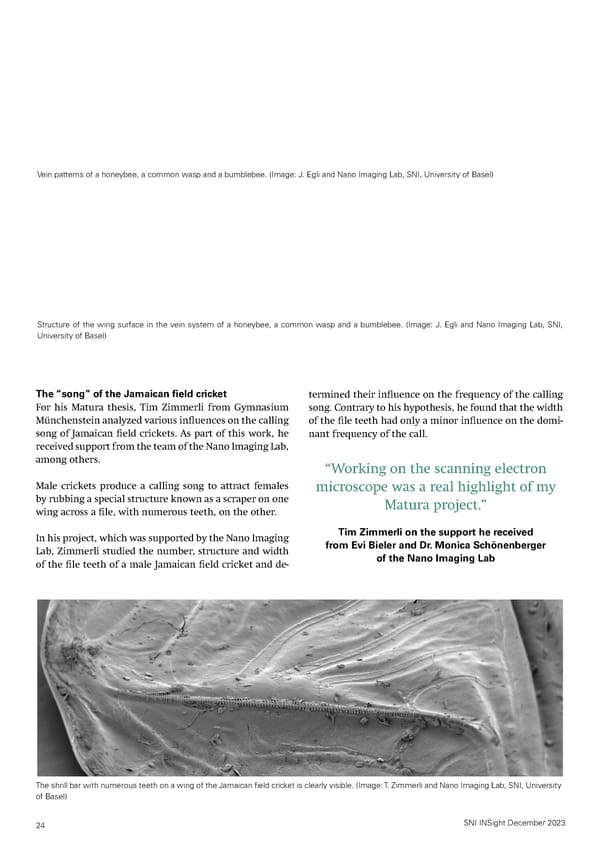
News from the SNI network Investigation of “magic” graphene Researchers from the SNI network have used an atomic force microscope in pendulum mode to study a two-layer graphene de- vice. In this bilayer graphene, the two layers of pure carbon were rotated by the “magic angle” of approximately 1.1° relative to one another. The results provide empirical proof that the method can be used to 昀椀ne-tune not only current 昀氀ow but also magnetization in the device. The results formed part of a doctoral thesis funded by the SNI and were recently published in the journal Communi- cations Physics. Further information: The two graphene layers are twisted relative to one anoth- https://nanoscience.unibas.ch/en/news/details/untersuchung-von-magischem-graphen/ er by the magic angle of approximately 1.1°. Depending on how many electrons a single cell is 昀椀lled with, the graphene Original publication: exhibits different electrical and magnetic properties. Measure- https://www.nature.com/articles/s42005-023-01441-4 ments can be made using the oscillating tip of an atomic force microscope. The green surface is doped with an excess of electrons, while the red surface is underdoped. Polarized cir- cular currents are induced by the magnetic 昀椀eld. (Illustration: Department of Physics, University of Basel) Better classification with machine learning Researchers from the SNI network have introduced a new ma- chine learning technique speci昀椀cally designed to enhance the analysis of protein unfolding using Atomic Force Microscopy (AFM) data. The team of Prof. Michael Nash (University of Basel and ETH Zurich) recently published the work in the scienti昀椀c journal Nano Letters. Further information: https://nanoscience.unibas.ch/en/news/details/bessere-klassifizierung-mithilfe-von-maschinel- Machine learning enhances the classi昀椀cation of unfolding pat- lem-lernen/ terns in proteins. (Image: V. Dof昀椀ni, Department of Chemistry, Original publication: University of Basel) https://pubs.acs.org/doi/10.1021/acs.nanolett.3c03026 “Andreev chemistry” on a nanowire Researchers at the University of Basel and Lund University have generated superconduct- ing pair states of electrons on several segments of a nanowire, separated by grown barriers. Depending on the height of the barriers, these pair states can be coupled and fused. The re- sults were recently published in the scientific journal Communications Physics and provide important insights for the development of new a) Andreev atoms: At high barriers, single, independent Andreev bound states are quantum states. formed – analogous to two single hydrogen atoms. b) Andreev molecules: If the Further information: barriers between the segments are reduced, coupled Andreev bound states are https://nanoscience.unibas.ch/en/news/details/andreev-chemie-auf-ei- formed – analogous to a hydrogen molecule. c) Andreev helium: At very low barri- nem-nanodraht/ ers, the individual ABSs merge so that the pair states extend over the entire nano- wire – analogous to a helium atom – conducting electric current without dissipation. Original publication: https://www.nature.com/articles/s42005-023-01273-2 SNI INSight December 2023 25 SNSF Starting Grant für Jonathan de Roo Der Schweizerische Nationalfonds (SNF) vergibt sechs weitere SNSF Starting Grants an die Universität Basel. Prof. Dr. Jonathan De Roo, Assistenzprofessor mit Tenure Track am Departement Chemie der Universität Basel, bekom- mt einen dieser Grants, um recycelbare Schwämme mit programmierbaren Strukturen aus Metall-Oxo-Clustern zu entwickeln. Diese Schwämme 昀椀nden Anwendungen als Katalysatoren, beispielsweise in der Herstellung von Arzneimitteln oder bei der Wasserreinigung. Weitere Informationen: https://nanoscience.unibas.ch/de/news/details/snsf-starting-grant-fuer-jonathan-de- roo/
Special issue in commemoration of Wolfgang P. Meier A special issue of Macromolecular Rapid Communications has been published dedicated to Wolfgang P. Meier, who passed away in Janu- ary 2022. In the editorial of the journal, Nico Bruns, Corinne Nardin and Cornelia G. Palivan describe the career of Wolfgang Meier and list all the articles contributing to this special issue. In their text, they also make it clear what a wonderful person Wolfgang Meier was, with whom we all associate very positive memories. Further information: https://nanoscience.unibas.ch/en/news/details/sonderausgabe-zum-gedenken-von-wolfgang-p-meier/ Editorial special issue: https://onlinelibrary.wiley.com/doi/10.1002/marc.202300401 Complete issue: https://onlinelibrary.wiley.com/doi/10.1002/marc.202300401 The special issue is dedicated to Wolfgang Meier. Vibrations of molecules visualized and studied Researchers from the SNI network have developed a new method for imaging the vibration of molecules. The scientists, led by Professor Ernst Meyer from the Department of Physics at the University of Ba- sel, have studied a speci昀椀c pyrene molecule on a silver surface using a scanning tunneling microscope (STM). Understanding molecular vi- bration is of crucial importance in a wide range of areas in molecular electronics, spintronics or in the development of quantum comput- ers, since vibrations a昀昀ect transport properties and spin dynamics. The work was recently published in the scienti昀椀c journal “Nature Communications”. Further information: https://nanoscience.unibas.ch/en/news/details/vibrationen-von-molekuelen-dargestellt-und-untersucht/ Original publication: https://www.nature.com/articles/s41467-023-41601-2 TBTAP molecules on a silver surface initially are nega- tively charged. If a positive voltage is then applied to the tip of an STM and brought close to the molecule, the molecule discharges.This discharge does not occur in one go, but rather in an oscillating manner. (Animation: Department of Physics, University of Basel) Chromium replaces rare and expensive noble metals Expensive noble metals often play a vital role in illuminating screens or converting solar energy into fuels. Now, chemists at the Univer- sity of Basel have succeeded in replacing these rare elements with a signi昀椀cantly cheaper metal. In terms of their properties, the new materials are very similar to those used in the past. Further information: https://chemie.unibas.ch/en/news/details-524/chrom-ersetzt-seltene-und-teure-edelmetalle/ Original publication: State-of-the-art chromium compounds act as lumines- https://www.nature.com/articles/s41557-023-01297-9 cent materials and catalysts. (Image: University of Basel, Jo Richers) 26 SNI INSight December 2023
SNSF Starting Grant for Jonathan de Roo The Swiss National Science Foundation (SNSF) is award- ing six SNSF Starting Grants to the University of Basel. Prof. Jonathan De Roo, assistant professor with tenure track at the Department of Chemistry at the University of Basel, has been awarded one of these grants to develop recyclable sponges with programmable structures made of metal-oxo clusters. These sponges have applications as catalysts, for example in the production of pharmaceuti- cals or in water puri昀椀cation. Jonathan de Roo has been awarded an SNSF Starting Grant. Further information: https://nanoscience.unibas.ch/en/news/details/snsf-starting-grant-fuer-jonathan-de- roo/ Marek Basler newly elected EMBO member Prof. Marek Basler of the Biozentrum, University of Ba- sel, has been elected as a new member of the renowned European Molecular Biology Organization (EMBO). Basler is now one of a select group of more than 2,000 leading life scientists in Europe and beyond who have so far been honored by EMBO for their outstanding research achievements with this lifetime membership. Further information: Marek Basler has been elected as a member of the European Mo- https://www.unibas.ch/en/News-Events/News/Ehrungen-und-Mitgliedschaften/ Marek-Basler-newly-elected-EMBO-member.html lecular Biology Organization (EMBO). (Image: Biozentrum, University of Basel) Dominik Zumbühl elected American Physical Society Fellow for 2023 Prof. Dominik Zumbühl, SNI member and director of the NCCR Spin, receives the award “For quantum transport experiments in semiconductor nanostructures at low temperatures studying coherence, spins, and spin-orbit coupling including developing and deploying laboratory instruments”. Further information: https://nanoscience.unibas.ch/en/news/details/dominik-zumbuehl-zum-ameri- Dominik Zumbühl has been elected American Physical can-physical-society-fellow-fuer-2023-gewaehlt/ Society Fellow for 2023. (Image: NCCR Spin) NZZ report: Quantum Computing An NZZ report published in September takes an in- depth look at quantum computing and highlights both the limitless potential and the risks associated with this ground-breaking technology. Further information: https://physik.unibas.ch/en/news/details/nzz-reportage-quantum-computing/ SNI INSight December 2023 27
Women in the SNI Network There are new videos in our series “Who are the women in nanoscience?”: https://nanoscience.unibas.ch/de/outreach/videos/frauen-im-sni-netzwerk/ Antonia Ruffo, SNI doctoral student at the Paul Scherrer Institut https://youtu.be/V386tx4PLFA Sina Saxer, Research associate at the FHNW School of Life Sciences https://youtu.be/YzNFfA4CiF8 Tamara Utzinger, who has just completed her master’s in nanoscienc- es at the University of Basel https://youtu.be/5t6SMUYxaj4 Antonia Ruffo, Sina Saxer, Tamara Utzinger, and Géraldine Guex talk Géraldine Guex about their careers, their motivation and their fascination for very dif- Professor for Oral Implantology, University Center ferent scienti昀椀c topics. of Dental Medicine Basel (UZB) https://youtu.be/4nbXd3jKkZ0 What exactly is nano? We’ve animated our “Was ist Nano?” brochure, in which you can now 昀椀nd easy-to-understand answers and in- sights into nanoresearch at the SNI partly illustrated with moving images. Brochure in German Was ist Nano? (“What is Nano?”): https://sniunibas.relayto.com/e/was-ist-nano-rppx3iftjvkzn?hub=651d6a40795e2 Annual Event 2023 From September 6—8, the members of the SNI network met for the Annual Event — which was held, for the 昀椀rst time, in the Canton of Aargau, speci昀椀cally at Lake Hallwil. It was a great conference, with exciting talks and post- ers on basic and applied research in wide-ranging areas of the nanosciences, as well as opportunities to network and exchange ideas. Video: For the 昀椀rst time, members of the SNI network met at Lake Hallwil for https://youtu.be/f4HHrbnXw88 their Annual Event. SNI INSight — Showcasing research and activities of the Swiss Nanoscience Institute Concept, text and layout: C. Möller, M. Poggio Translations and proof-reading: UNIWORKS (Erlangen, Germany) Image credits: C. Möller and named sources © Swiss Nanoscience Institute, December 2023 SNI INSight December 2023 28
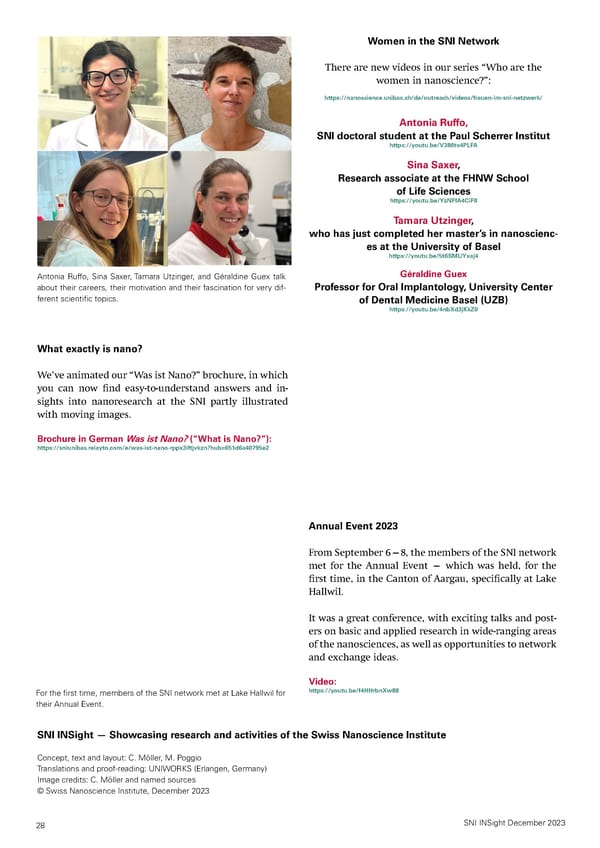


Educating Talents since 1460. Swiss Nanoscience Institute University of Basel University of Basel Petersplatz 1 Klingelbergstrasse 82 4001 Basel 4056 Basel Switzerland Switzerland www.unibas.ch www.nanoscience.ch

